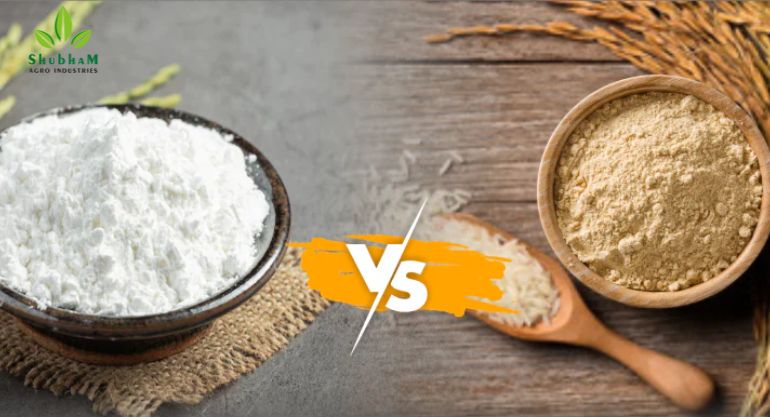Difference Between Rice Flour and Wheat Flour

Introduction:
In the culinary world, flour serves as the fundamental building block for a myriad of dishes, ranging from delicate pastries to hearty bread. Among the diverse selection of flours available, rice flour and wheat flour emerge as prominent contenders, each offering its own unique characteristics and culinary applications. At Shubham Agro Industries, we're committed to providing premium flour products that cater to the diverse needs of our customers. In this comprehensive exploration, we'll delve into the nuanced differences between rice flour and wheat flour, shedding light on their distinctive qualities and culinary uses.
1. Source and Composition:
Rice Flour:
Derived from finely milled rice grains, rice flour is a gluten-free alternative that caters to individuals with dietary restrictions or sensitivities. It boasts a fine texture and a neutral flavour profile, making it versatile for a wide range of recipes, both sweet and savoury.
Wheat Flour:
Wheat flour, on the other hand, is derived from grinding wheat kernels into a fine powder. It contains gluten, a protein that provides elasticity and structure to baked goods. Available in various forms such as all-purpose flour, bread flour, and whole wheat flour, it offers a diverse range of culinary possibilities.
2. Gluten Content:
Rice Flour:
One of the defining characteristics of rice flour is its gluten-free nature, making it suitable for those with gluten intolerances or celiac disease. This makes rice flour an essential ingredient in gluten-free baking and cooking, ensuring that individuals with dietary restrictions can still enjoy delicious meals and treats
Wheat Flour:
Wheat flour contains gluten, which contributes to its elasticity and ability to rise when baked. While this makes wheat flour ideal for traditional baking applications, it also means that individuals with gluten sensitivities must seek alternative flours to accommodate their dietary needs.
3. Texture and Flavor:
Rice Flour:
With its smooth, powdery texture and subtle flavour, rice flour lends itself well to a variety of culinary creations. From delicate cakes and pastries to crispy tempura batter and thickening sauces, rice flour adds lightness and tenderness to dishes without overpowering other flavours.
Wheat Flour:
Wheat flour offers a slightly coarser texture compared to rice flour and a more pronounced flavour profile. Depending on the variety, wheat flour can range from nutty and earthy to sweet and buttery, adding depth and richness to baked goods and savoury dishes alike.
4. Culinary Applications:
Rice Flour:
Rice flour's versatility makes it suitable for a wide range of culinary applications. It can be used as a thickening agent in soups and sauces, a coating for fried foods, a base for gluten-free baking, and even as a substitute for wheat flour in certain recipes. Its ability to produce light and tender textures makes it invaluable in gluten-free cooking.
Wheat Flour:
Wheat flour is a staple ingredient in traditional baking and cooking, where its gluten content provides structure and elasticity to doughs and batters. It is used to make bread, cakes, pastries, pasta, and a variety of other baked goods. While not suitable for those with gluten sensitivities, wheat flour remains a versatile and essential ingredient in many culinary traditions worldwide.
Conclusion:
In summary, the distinctions between rice flour and wheat flour are evident in their source, composition, gluten content, texture, flavour, and culinary applications. Whether you're seeking a gluten-free alternative or experimenting with traditional baking techniques, both flours offer unique benefits and endless possibilities for culinary creativity. At Shubham Agro Industries, we're dedicated to providing premium flour products that meet the highest standards of quality and taste, ensuring that our customers have the ingredients they need to bring their culinary visions to life.
